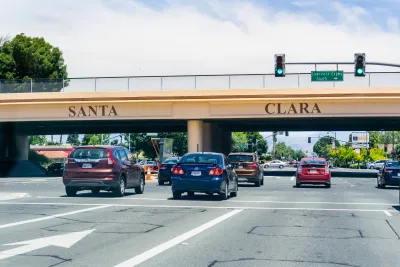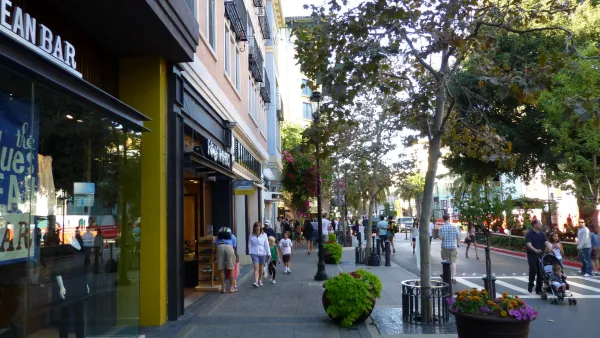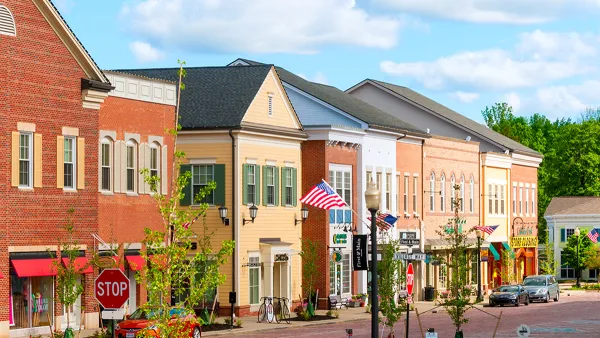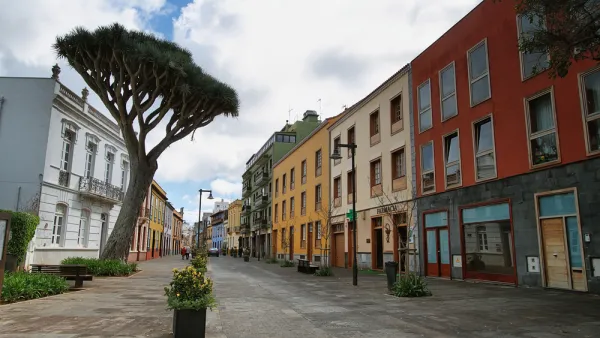The built environment in one of the most affluent places in the country leaves much to be desired. Why are Silicon Valley communities missing so many key urban features?

Picture Silicon Valley and you might imagine “techies doing cool tech things on every sidewalk, in every restaurant and juice bar, in every garage and loft, on every bus, train, scooter, and hoverboard.” But that’s far from the reality, writes Josh Stephens in Common Edge.
The real Silicon Valley is so dull, it makes you want to climb atop the nearest standing desk and hurl yourself off headfirst. It makes you want to put on VR goggles and never take them off.
For Stephens, Santa Clara, arguably the center of Silicon Valley, is “somehow, even more bleak” than its endless office parks, strip malls, and mid-density apartment complexes would imply. With an average home price of $1.5 million and rents at over $3,000 per month, Santa Clara is an unusual yet “ordinary example of 20th century urbanism.” A bigger question might be, “is Santa Clara’s bleakness a feature or a bug? Why do all of those wealthy people and wealthy companies want to live with all of that ugliness?”
The wealth in Santa Clara, unlike more ostentatious enclaves like, say, Beverly Hills, is hidden, Stephens writes, in part because if it was more apparent, maybe people would demand a more livable, affordable community. “Meanwhile, all over the Bay Area, young professionals sleep on sofas; public-sector workers commute in from beyond the horizon; people reside in boxes up in the Tenderloin; and low-income workers without cars live extralegally wherever they can.”
Stephens asserts that Santa Clara “warrants scrutiny for all that it has squandered,” using none of its immense wealth to create anything close to a vibrant city. “If the city harnessed even a fraction of the capital sloshing around its city limits, it could transform itself into a model of equity, sustainability, and creativity.”
Stephens concludes that “Santa Clara’s underperformance is not a moral failing exactly. Cities rise and fall collectively.” Santa Clara may offer a high-profile example of our failures, but it’s nevertheless part of a collective failure.
FULL STORY: Is Santa Clara—the Heart of Silicon Valley—Soulless and Banal by Intent?

Analysis: Cybertruck Fatality Rate Far Exceeds That of Ford Pinto
The Tesla Cybertruck was recalled seven times last year.

National Parks Layoffs Will Cause Communities to Lose Billions
Thousands of essential park workers were laid off this week, just before the busy spring break season.

Retro-silient?: America’s First “Eco-burb,” The Woodlands Turns 50
A master-planned community north of Houston offers lessons on green infrastructure and resilient design, but falls short of its founder’s lofty affordability and walkability goals.

Test News Post 1
This is a summary

Analysis: Cybertruck Fatality Rate Far Exceeds That of Ford Pinto
The Tesla Cybertruck was recalled seven times last year.

Test News Headline 46
Test for the image on the front page.
Urban Design for Planners 1: Software Tools
This six-course series explores essential urban design concepts using open source software and equips planners with the tools they need to participate fully in the urban design process.
Planning for Universal Design
Learn the tools for implementing Universal Design in planning regulations.
EMC Planning Group, Inc.
Planetizen
Planetizen
Mpact (formerly Rail~Volution)
Great Falls Development Authority, Inc.
HUDs Office of Policy Development and Research
NYU Wagner Graduate School of Public Service




























